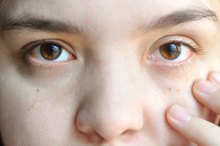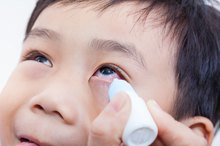Red Eyes After an Exercise
Strenuous exercise can make the whites of your eyes turn red. A number of factors can cause the appearance of red eyes, but in nearly all instances the condition is easily treated and resolved. If you develop a severe case of red eyes during or after exercise, speak to your doctor. He can help make a diagnosis and recommend effective treatment.
Exercise
Certain forms of exercise, such as lifting weights, require straining and cause momentary spikes in your heart rate. The strain and increase in blood flow builds up pressure in your head, which causes blood vessels to expand, including those in your eyes. If the pressure is too great, the tiny blood vessels in your eye can burst and make the sclera -- the white part of your eye -- appear red. The more strenuous the exercise, the greater the amount of pressure that builds in your head.
- Certain forms of exercise, such as lifting weights, require straining and cause momentary spikes in your heart rate.
- The strain and increase in blood flow builds up pressure in your head, which causes blood vessels to expand, including those in your eyes.
Irritation
Blood Shot Eyes When Working Out
Learn More
Certain irritants can cause your eyes to turn red. Sweat can easily get into your eyes during exercise, causing them to sting. The sweat also inflames the eyes' blood vessels. Natural elements, such as allergens, wind and dust can also irritate your eyes and inflame the blood vessels when exercising outdoors. Certain climates are harsher on eyes than others, but ultimately it is your sensitivity to allergens and your eyes' resilience to natural elements that determine the severity of your red eyes.
- Certain irritants can cause your eyes to turn red.
- Natural elements, such as allergens, wind and dust can also irritate your eyes and inflame the blood vessels when exercising outdoors.
Subconjunctival Hemorrhage
Some people develop a severe case of red eyes in which nearly the entire white area of the eye appears red and bloodshot. Such extreme instances of red eyes are caused by subconjunctival hemorrhages; these can occur especially during exercises that require intense straining. During a subconjunctival hemorrhage, blood vessels in the eye rupture and blood spreads on the surface of the eye. The blood does not leak out of the eye because of the conjuctiva -- the clear membrane that covers the eye. The conjuctiva does not absorb blood quickly, so the blood remains trapped on the eye until the hemorrhaging stops and the body can resorb the blood. A subconjunctival hemorrhage rarely requires medical attention. The blood typically clears up within 10 to 14 days from the time of the hemorrhage.
- Some people develop a severe case of red eyes in which nearly the entire white area of the eye appears red and bloodshot.
- During a subconjunctival hemorrhage, blood vessels in the eye rupture and blood spreads on the surface of the eye.
Treatment and Prevention
How to Reduce Eye Redness
Learn More
You can relieve the irritation and inflammation of red eyes by applying over-the-counter eyedrops. The clear solution in eyedrop products cools the eyes and eases itchiness from irritation. Eyedrops also help slow any hemorrhaging that is occurring in the eyes. Choose artificial tears over anti-redness eyedrops. The ingredient oxymetazoline in anti-redness drops can cause a redness rebound effect if you use the drops excessively or longer than a couple of days. If you have sensitive eyes and exercise outdoors, wear eye protection, such as sunglasses or clear athletic glasses designed to block wind and air particles from getting into your eyes. When performing strenuous exercise, focus on continuously breathing. Avoid holding your breath when lifting heavy weights. This only adds to the strain and pressure that builds in your head.
- You can relieve the irritation and inflammation of red eyes by applying over-the-counter eyedrops.
- The ingredient oxymetazoline in anti-redness drops can cause a redness rebound effect if you use the drops excessively or longer than a couple of days.
Medical Attention
Though most cases of red eyes resolve on their own, you should seek medical attention if your condition lasts for more than two days. You should also see your doctor if you experience pain in your eyes or your vision changes. Seek emergency medical attention immediately if your eyes turn red after having been penetrated, or you develop a headache, blurred vision and are confused. Nausea and vomiting, along with seeing halos around lights, are other serious symptoms that require immediate professional care.
- Though most cases of red eyes resolve on their own, you should seek medical attention if your condition lasts for more than two days.
Related Articles
References
- MedlinePlus; Eye Redness; Jan. 4, 2011
- Health Central; Bloodshot Eyes; May 2006
- "Los Angeles Times"; Rebound Redness with Eyedrop Use; Joe Graedon, et al.; May 2009
- Sheppard AL, Wolffsohn JS. Digital eye strain: prevalence, measurement and amelioration. BMJ Open Ophthalmol. 2018;3(1):e000146. doi:10.1136/bmjophth-2018-000146
- Javadi MA, Feizi S. Dry eye syndrome. J Ophthalmic Vis Res. 2011;6(3):192-8.
- Solano D, Czyz CN. Viral Conjunctivitis. StatPearls Publishing. Updated November 18, 2018.
- Putnam CM. Diagnosis and management of blepharitis: an optometrist's perspective. Clin Optom (Auckl). 2016;8:71-78. doi:10.2147/OPTO.S84795
- Duplechain A, Conrady CD, Patel BC, Baker S. Uveitis. StatPearls Publishing. Updated June 3, 2019.
- Shimizu A, Maruyama K, Yokoyama Y, Tsuda S, Ryu M, Nakazawa T. Characteristics of uveitic glaucoma and evaluation of its surgical treatment. Clin Ophthalmol. 2014;8:2383-9. doi:10.2147/OPTH.S72383
- Mclaurin E, Cavet ME, Gomes PJ, Ciolino JB. Brimonidine Ophthalmic Solution 0.025% for Reduction of Ocular Redness: A Randomized Clinical Trial. Optom Vis Sci. 2018;95(3):264-271. doi:10.1097/OPX.0000000000001182
- Hazlett L, Suvas S, Mcclellan S, Ekanayaka S. Challenges of corneal infections. Expert Rev Ophthalmol. 2016;11(4):285-297. doi:10.1080/17469899.2016.1203254
- Sahinoglu-keskek N, Cevher S, Ergin A. Analysis of subconjunctival hemorrhage. Pak J Med Sci. 2013;29(1):132-4. doi:10.12669/pjms.291.2802
- Petsas A, Chapman G, Stewart R. Acute angle closure glaucoma - A potential blind spot in critical care. J Intensive Care Soc. 2017;18(3):244-246. doi:10.1177/1751143717701946
- Salama A, Elsheikh A, Alweis R. Is this a worrisome red eye? Episcleritis in the primary care setting. J Community Hosp Intern Med Perspect. 2018;8(1):46-48. doi:10.1080/20009666.2017.1418110
- Yenerel NM, Küçümen RB. Pregnancy and the Eye. Turk J Ophthalmol. 2015;45(5):213-219. doi:10.4274/tjo.43815
- Portello JK, Rosenfield M, Chu CA. Blink rate, incomplete blinks and computer vision syndrome. Optom Vis Sci. 2013;90(5):482-7. doi:10.1097/OPX.0b013e31828f09a7
- Talhout R, Schulz T, Florek E, Van benthem J, Wester P, Opperhuizen A. Hazardous compounds in tobacco smoke. Int J Environ Res Public Health. 2011;8(2):613-28. doi:10.3390/ijerph8020613
- Vella LD, Cameron-smith D. Alcohol, athletic performance and recovery. Nutrients. 2010;2(8):781-9. doi:10.3390/nu2080781
- 1.Wu, Brian. "Red eyes: List of common causes." Medical News Today, 4 Mar 2017.
- 2. Chaudhary, Omar R, MD. "What causes red eye?" Eyesmart, American Academy of Ophthalmology, 17 June 2015.
Writer Bio
Dan Harriman began writing professionally in 2009 and has a varied background in marketing, ranging from sports management to music promotion. Harriman holds a Bachelor of Science in journalism with an emphasis on strategic communications from the University of Kansas and earned the International Advertising Association's diploma in marketing communications.









